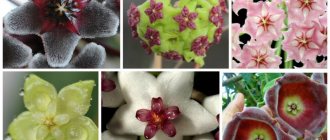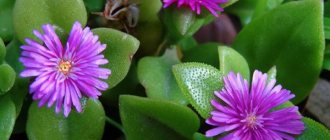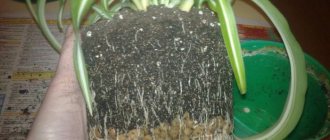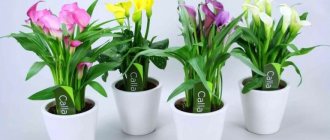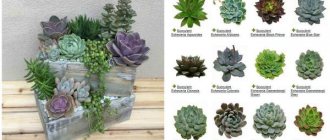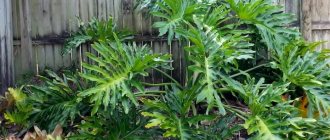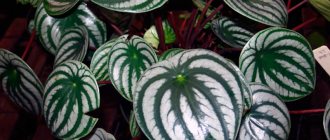Nowadays, plants of unusual colors, especially red, are gaining popularity, and we are not talking about the color of the flowers themselves. Plants with red leaves look fresh, bright, beautiful, interesting, they can charm at first sight and decorate any room. By the way, the red color appears due to anthocyanin pigments. There are a lot of ideas on how to decorate your home or work space with such plants! You can make a green corner by immediately combining different crops with green and red foliage, or create a simpler composition, or you can simply put one bright specimen in a prominent place.
Poinsettia
The beautiful poinsettia is also called Euphorbia most beautiful, Christmas star. A bright representative of the Euphorbiaceae. The most beautiful euphorbia is loved for its unpretentiousness and longevity - it is literally capable of delighting with its beauty for many years, requiring in return minimal but regular care.
Conditions for growing beautiful milkweed:
- Temperature: in summer about +20-25°C, in winter - about +16.
- Lighting: full, a south or south-east window is suitable.
- Watering: moderate, about 2 times in 7 days, in cold weather - 1 time in 3-4 weeks.
- Air humidity: normal, spraying with water is welcome, poinsettia can withstand dry air, but it has a bad effect on decorativeness.
- Pests: scale insects, spider mites, thrips.
- Reproduction: by apical stem cuttings.
Growing Fittonia in an aquarium
The presented plant can be grown in a transparent container made of glass or plastic, reminiscent of a fish aquarium. All plants that require high humidity can be grown in florariums - these are special semi-closed containers for plants.
Most often they have a round shape and a wide neck, and fit well into the interior of the apartment and flower compositions.
In addition, growing Fittonia in a florarium makes it easier to care for and protects the plant itself from drafts, temperature changes, and drying out of the soil. The flower should be watered no more than 1-2 times a month.
Planting the plant is somewhat different: you need to put a little soil at the bottom of the container, plant a Fittonia bush in it and water it generously. After a few hours, condensation appears on the lid, after which the florarium should be opened for several hours to bring in fresh air.
The described procedure must be done for 7-10 days until the plant takes root well. Fittonia in the florarium should not be allowed to grow; as the bush grows, it is thinned out.
DIY florarium
Caladium
Thanks to its leaves, caladium looks more like some kind of extraterrestrial plant. It is distinguished by a combination of interesting colors and colorful veins.
Conditions for keeping and caring for caladium:
- Temperature: in summer - 20-25, in winter - 15-19.
- Lighting: grown in bright places that are protected from direct sunlight, comfortable on an east or north-west window.
- Watering: moderate, when adding moisture, do not allow water to get on the leaves, stops in winter.
- Humidity: high, regular spraying of the soil surface is recommended.
- Reproduction: daughter tubers.
- Pests: aphids, mealybugs.
- Feature of the culture: in the fall the leaves begin to die and in the winter the caladium is dormant.
Types of Fittonia domestica with photos and names
The most popular types of this plant are:
Fittonia Verschaffelta
This low plant has large oval leaves and branching stems.
Fittonia silvervein
The name describes the pattern of the leaves: silvery veins cover their entire surface.
Fittonia Fortissimo
The leaves of the plant are round, bright green with pink veins.
Fittonia Frankie
Coral elongated leaves are decorated with an olive stripe along the entire perimeter.
Fittonia Josan
Red leaves complemented by a green border.
Fittonia Pearcei
Pink veins adorn the velvety green leaves.
Fittonia Mosaic Kings Cross
This plant has an unusual appearance: the leaves are distinguished by a soft white hue, and their edges are not straight, but wavy.
Fittonia Skeleton
A network of red veins covers the entire surface of the olive-yellow leaves.
Fittonia is a beautiful plant that is highly prized for its intricate patterns on its leaves. Although this Peruvian beauty can be called picky, we can provide her with the necessary warmth and care. And in gratitude, she will decorate the room with herself for a long time, raising the mood with her colorful outfit.
Aglaonema
The evergreen exotic is a member of the Araceae or Aronicaceae family. Grows well in regular substrate and hydroponics.
Conditions for aglaonema:
- Temperature: in the warm period - 20-25 degrees, in the cold - 16-18, but not lower.
- Lighting: full, but diffuse, south-west or south-east windows are suitable.
- Watering: plentiful in the summer, reduced later, but you need to make sure that the soil in the pot never completely dries out.
- Humidity: high, requires spraying with warm water.
- Reproduction: seeds, apical cuttings, suckers, dividing the bush.
- Pests: spider mites, mealybugs.
The most common types for decorating a room
Poinsettia
The culture belongs to the Euphorbiaceae family. It is also called the “Christmas star” because it blooms for the New Year. Its most cultivated varieties are spherical, sparkling and large-horned. The plant is native to Mexico. Subspecies have been noted in which red leaves grow from the middle of the bush, while in others the redness is visible from the inside on the green leaf. The flower does not tolerate temperature changes, drafts, shade and heat. It is favored by diffused sunlight, spraying and regular watering. During dormancy, the leaves fall off and the crop does not look aesthetically pleasing. The flower is propagated by cuttings, each containing five fresh leaves. Spider mites and scale insects often appear on it. The juice of the flower is poisonous. Therefore, transplantation and circumcision work should be carried out only with gloves and carefully.
Cordilina
The plant looks like a palm tree and its height ranges from 40 to 50 cm. It is a subshrub and belongs to the agave family. It is loved for its long red leaves gathered into a tight crown. There are other varieties: with green and red-white variegated foliage. Over time, the leaves at the bottom of the trunk dry out and fall off, leaving it bare. The flower loves diffused lighting, warmth and infrequent watering. It is favorably affected by an air temperature of 20-23 °C in summer, in winter - 13-17 °C, excess moisture is destructive, and spraying and replanting every year has a positive effect on the growth of the flower. Unfortunately, spider mites are often its guest.
Irezine
The plant is a perennial and belongs to the amaranth family. Most often found in apartments is the Herbst variety, which has ellipsoidal leaves colored red and burgundy. There are species with dark green foliage, where each leaf is covered with crimson-colored veins. The flower is not whimsical, it likes diffused light, and the temperature regime is indifferent. The flower is resistant to pests and tolerates dryness in the apartment during the heating season and even drought.
Nidularium
Belongs to the bromeliad family. Its homeland is the tropical region of America. A distinctive feature is the absence of a stem. Elongated red leaves with jagged edges are formed during the flowering period. As soon as the nidularium fades, the wonderful rosette disappears, and in its place, children are formed on the sides, which soon begin to bloom, due to which the plant quickly increases in volume. The flower must be protected from direct sun, make sure that the soil in the pot and the atmosphere in the room are sufficiently moist.
Oxalis triangularis
This flower has no stems and belongs to the oxalis family. Also known as “rabbit cabbage”. Red-violet leaves with carved edges are located on elongated petioles, which rise in the morning and fall in the evening. The white flowers of the plant are lonely and unsightly. Because of its leaves, which resemble butterflies collecting nectar, the flower has another name: “Madama Butterfly”. The foliage can be eaten. When growing wood sorrel at home, the container with it must be placed in a bright place, otherwise the foliage will darken and its color will approach green. It is necessary to moisten the soil as it dries. The plant is fed in spring and summer using liquid fertilizers.
Cordilina
Cordyline leaves are highly decorative. Representative of the Sparzhevs. The crop can be grown in soil or hydroponically.
Features of growing Cordyline:
- Temperature: in summer - 20-25 degrees, in cold weather - not lower than 18, should be protected from drafts.
- Lighting: A bright place is suitable for variegated cordylines, but direct sunlight should be completely excluded.
- Watering: in summer, moisture should be added abundantly, avoiding drying out or waterlogging of the earthen clod; later they are reduced, but you should also not allow the soil to dry out.
- Air humidity: high, regular spraying is recommended.
- Reproduction: through seeds, division of rhizomes, cuttings.
- Pests: aphids, thrips, scale insects.
Description of appearance
A bushy perennial plant can reach a height of 40-50 cm. The juicy and fleshy stem at the base can have a red or burgundy tint. The leaves are oblong, pointed at the top, bright or dark green with contrasting red veins.
In June and early July, the plant develops flower stalks with inflorescences of small, star-shaped flowers. Unprepossessing, pale, they do not add decorative value to the plant, at the same time taking nutrients from it, the leaves turn pale, and the plant loses its effectiveness. Therefore, experts recommend removing them at the very beginning of their appearance.
Peduncles are left only on some bushes if they plan to collect sorrel seeds for subsequent planting. The main thing is to collect them on time. If you miss time, they will scatter throughout the garden and grow in places where the gardener did not plan to plant them.
Red sorrel looks great on the shore of a natural or artificial reservoir, especially since it is not afraid of flooding. The more water it receives, the brighter and larger its “greens” will be.
Coleus
Coleus has two strong advantages: firstly, it is unpretentious, and secondly, it is very colorful and beautiful. Many of them have interesting colors - green borders around the edges and a mottled middle. Representative of the Lamiaceae (or Lamiaceae).
In order for Coleus to please its beauty, it is necessary to satisfy its requirements:
- Temperature: in summer +18-20°C, in winter +12-14, not lower.
- Lighting: for maximum decorativeness, the crop requires full lighting, but direct exposure to rays should not be allowed, the light must be diffused.
- Watering: in spring and summer, abundantly when the top layer of soil in the pot dries, in the cold period it is reduced, but the soil should not be allowed to dry out.
- Air humidity: high, spraying will be beneficial.
- Pests: whitefly, spider mites, aphids.
- Reproduction: cuttings, less often seeds.
Soil mixture and replanting
The Fittonia flower is growing quickly. Therefore, it is advisable to replant annually. Since the roots of the plant are weak and shallow, choose a flat, wide pot. A layer of drainage must be poured onto the bottom to a height of approximately 1/3 of the pot.
The substrate for fittonia can be purchased at the store or prepared yourself. In the latter case, it is enough to mix leaf soil with peat, sand and humus in a ratio of 3:1:1:1, respectively.
Oxalis (Oxalis)
Oxalis, oxalis, lucky clover, sour clover, hare cabbage - these are different names for the same plant. By the way, such names were chosen for a reason; the leaves of the representative of the Kislichny family are really sour. Flower growers are very fond of this crop for its colorful and delicate leaves that resemble butterflies. Oxalis is exactly the case when not only the color, but also the shape of the leaves causes admiration.
Some nuances that are important to know for successfully growing sorrel at home:
- Temperature: in summer 20-25, in winter - 16-18.
- Lighting: bright, but always diffused; direct rays can cause burns.
- Watering: plentiful, but the drainage system must be of very high quality, excess moisture is critical for it, during cold periods the amount of water decreases, you just need to maintain light moisture in the substrate.
- Humidity: moderate to slightly higher than normal room humidity.
- Pests: scale insects, aphids.
- Reproduction: by nodules or daughter bulbs.
Watering and moistening
So we have reached the cornerstone in growing Fittonia. Watering should be such that the soil does not dry out, but is not overly saturated with moisture. Drying causes shedding of leaves and death of shoots.
And from pouring there is a risk of root rotting. The situation is complicated by the fact that Fittonia leaves actively evaporate moisture. This phenomenon is called transpiration. Therefore, the soil in the pots dries out quite quickly. No pronounced rest is observed. But in winter, growth slows down, which means the frequency of watering is reduced.
Dry air is undesirable for a flower. Humidity should be maintained regularly using spraying or household humidifiers. The rule is especially relevant at the height of the heating season.
Nidularium
Attractive because of its glossy, shiny, dense leaves. The highlight of nidularium is given by the bracts, colored red. Refers to Bromeliads.
The following conditions are suitable for decorative deciduous plants:
- Temperature: in warm weather +20-24°C, in cold weather +18-20.
- Lighting: partial shade, strong shadow and direct sunlight are not allowed.
- Watering: moderate, waterlogging should not be allowed; moisture should be added when the soil dries out. In spring and summer, it is recommended to add moisture through the leaf funnel, and in the cold period - in the standard way.
- Humidity: normal room humidity, in dry air you need to spray the leaves.
- Pests: scale insects, mealybugs.
- Reproduction: daughter rosettes.
Recommendations for owners of exotic indoor flowers
- 1. When considering the plant you want to buy, make sure that it is not damaged. It is advisable to contact a store employee with a request to release the flower from the transparent packaging wrapper and test the leaves for tightness, and also make sure that the ground is moist. If the picturesqueness and heating indicators are insufficient, it is better not to make this purchase.
- 2. Having brought home a flower, you will need to provide it with quarantine conditions. To do this, it is placed in a separate place, as far as possible from other indoor crops. After seven days, the flower must be transplanted into a larger pot, replacing the soil with a nutrient substrate.
- 3. Do not let the soil become too dry or waterlogged. The flower should not be placed in dark areas or in direct sunlight. Improper care has consequences. The plant loses its beauty and uniqueness; burns and unsightly spots appear on its leaves.
Flowers with red-green leaves are extremely beautiful. The deep red color has always attracted everyone. Perhaps that is why flower growers are of increased interest in these crops.
Croton (Codiaeum)
Croton has attractive leaves. The codiaum flower is not particularly decorative; it is often simply torn off so that it does not take away excess energy. A representative of the Euphorbiaceae family has a truly fantastic color, combining several colors at once: red, yellow, green, pink, orange. This amazing combination will appeal to lovers of picturesque and rich colors. Codiaum also has an interesting feature - milky sap in the stems and leaves.
However, croton is demanding in care; it cannot be called unpretentious and unpretentious:
- Temperature: in summer +20-23, in winter +17-18, t should not fall below 17 degrees. It is also important to avoid any drafts.
- Watering: abundant in spring and summer, perform the procedure when the top layer of soil dries 1 centimeter. In winter, the introduction of moisture is reduced.
- Air humidity: high, it is necessary to regularly spray the leaves and clean them of dust.
- Lighting: should be full, but should be protected from direct rays. Therefore, it is better to place the pot on the east or west side.
- Pests: rarely affect due to the poisonous sap, but under unfavorable conditions (dry air) scale insects are possible.
- Reproduction: apical cuttings, air layering.
Caring for Fittonia at home. Details
Every gardener who has Fittonia is well aware of home care. Every little detail is important so that the plant feels good and enjoys its colorful beauty for a long time.
Landing
Planting Fittonia seeds is mainly done in May. This process is divided into the following stages:
- Soil preparation. You need to mix peat, sand, turf and coniferous soil. It is recommended to pre-steam the soil or pour boiling water over it.
- Preparing the container. Expanded clay drainage should be placed at its bottom, and soil should be placed on it.
- Planting seeds in moist soil. They should be lightly sprinkled with soil on top.
- Creation of a greenhouse climate. To do this, cover the container with a plastic bag or glass.
It is necessary to ensure that the soil is constantly moist. The temperature in the room is allowed in the range from +220C to +250C. As soon as the first shoots appear, the covering must be removed. When the leaves appear, you need to plant them in separate small pots.
Fittonia flowering
The owners of this plant differ in their attitude towards flowering.
Some people consider them unnecessary and cut them off. And someone rejoices at their appearance. The flowers are small and white. If the plant variety is hybrid, flowering should not be expected.
Temperature
The interval from +200C to +240C is most comfortable for indoor Fittonia. If the temperature drops below, the development of the plant slows down and growth stops.
Temperatures below +80C are destructive: Fittonia loses its foliage and then dies completely. Although the plant needs fresh air and the room must be ventilated, drafts and sudden temperature changes are not allowed. Therefore, it is not recommended to place the pot on the terrace or balcony, even in summer.
Spraying
Homemade Fittonia loves high humidity; it can be provided in three ways:
- Regularly spray the leaves with settled water at room temperature.
- Place the pot in a tray containing moss or damp expanded clay.
- Use an automatic humidifier.
In winter, it is necessary to protect the plant from direct warm radiation from radiators.
Lighting
Fittonia needs good lighting, but if it is intense it can fade. If the pot is placed on a window facing south or west, it is necessary to provide protection from direct sunlight by hanging tulle. If the window faces north, the plant does not receive enough sunlight and needs to be supplemented with fluorescent lamps.
Optimal lighting is from windows facing east.
Don't forget about the phytolamp! This is an excellent solution for additional lighting and rapid development of the plant.
Watering
Indoor Fittonia requires regular and abundant watering, since a large amount of moisture evaporates from the surface of its leaves.
However, even here, excess water is dangerous, because of which the roots of the plant begin to rot. Lack of moisture is dangerous because the plant will lose leaves. Watering in winter is less intense than in summer. Water for irrigation is used from rain, filtered or settled water.
Pot for fittonia
It is important to choose the right pot for this plant, since its quality depends on the comfort and lifespan of Fittonia. Drainage holes are required to allow excess moisture to escape.
The size of the pot should not be too large, otherwise the root system will develop deeper, and Fittonia at home will grow more slowly.
The material for the pot is opaque plastic or glazed ceramic.
Soil for fittonia
For the Fittonia plant, the “Violet” and “Geranium” mixtures, which are sold in stores, work well. You can also prepare the soil yourself by mixing turf soil, coniferous soil, peat and sand.
You need to ensure that the soil is loose and moist.
Feeding and fertilizer
At the end of the dormant period, Fittonia begins intensive growth, and then it is recommended to help it with regular feeding. Mineral complex fertilizers are often used, which need to be applied once every 2 weeks.
It should be remembered that the Fittonia flower at home is highly sensitive to minerals and fades when there is an excess of them, so you need to dilute mineral fertilizers in water in a volume that is half that specified in the instructions.
Choose the right fertilizer for yourself !
Fittonia transplant
When the plant is young, it must be replanted every year in the spring.
When the domestic Fittonia is already an adult, this procedure is carried out less frequently: once every 2-3 years. A suitable replanting method is transshipment, since replacing the soil can damage fragile shoots.
How to prune fittania?
The pruning procedure coincides with replanting. This is done to rejuvenate the plant and improve its condition. Cut off shoots that have become elongated during the dormant period.
In addition to pruning, it is also necessary to pinch the tops of young shoots so that Fittonia grows wider rather than upward.
Rest period
This is a period during which the plant “rests”; it requires less watering and fertilizers. The dormant period of Fittonia includes the autumn and winter months, however, even during them you should not forget about watering - although it is reduced, it is necessary. You also need to ensure a constant temperature throughout the year.
Irezine
The compact bush amazes with its lush and colorful beauty. The variegated leaves are painted in an attractive beet red color.
Features of growing irezine at home:
- Temperature: in the warm period - 19-25 degrees, in the cold - 15-18.
- Lighting: the light-loving crop prefers full lighting; on a south window it is recommended to make it diffused.
- Watering: abundant (when the top layer of the substrate dries out), reduced in winter, but do not allow the soil to dry out.
- Humidity: normal, periodic spraying will be beneficial.
- Pests: aphids, whiteflies.
- Reproduction: stem cuttings.
- Feature of caring for irezine: you should periodically pinch the tops of the shoots to form a beautiful bush.
Varieties
Fittonia belongs to the Acanthus family, which includes other favorites of florists - Pachistachis, Crossandras. The genus is small in number, represented by several species, the most famous of which are:
- Gigantic. This is the only variety that has erect, woody stems 50-60 cm high. The leaf blades are dark green, the width reaches 10 cm.
- Verschaffelt. In contrast to the first, this is a low-growing, highly branched flower with creeping shoots. The leaves are green or olive in color, no more than 5-10 cm in length.
The varieties Skeleton, White Anna, and Perseus grow well at home.
Neoregelia
It is similar to Nidularium, but this is not surprising, because they belong to the Bromeliads. Neoregelia is attractive because of its beautiful glossy leaves and variegated bracts.
The conditions acceptable for neoregelia are simple:
- Temperature range: in summer +21-25°C, in winter - +16-18. It is very important that there is good ventilation and neoregelia has access to fresh air, but it should be protected from drafts.
- Lighting: bright diffused light without direct light.
- Watering: you need to pour water into the rosette of leaves, in winter - under the root.
- Humidity: high, it is recommended to use a humidifier or spray frequently. It is also important to remove dust from the surface of the leaves.
- Pests: aphids, mealybugs, bromeliad scale insects.
- Reproduction: daughter rosettes.
Diseases and pests
Phytonia, as a rule, does not get sick and does not have any specific pests. Most often, the plant suffers from such “omnivorous” parasites as scale insects.
Pest control - table
| Pest | Symptoms | Control and prevention measures |
| Shchitovka | On the underside of the leaf blade, in the places where the shoots branch, dull grayish-brown plaques appear - the shells of pests sucking the juice out of the plant. Fittonia stops growing, the leaves turn yellow, dry out and fall off. | If you find a scale insect, isolate the plant. Disinfect the area of the window sill where it stood. Whip up a thick foam of laundry or green potassium soap and apply it to the flower with a soft cloth or sponge. Treat hard-to-reach places with a cotton swab. Let the plant sit for 30-40 minutes, placing a plastic bag over the top and sealing it tightly. Then give the flower a warm shower, washing off the remaining foam. In particularly advanced cases, chemicals are immediately used. Read the instructions carefully and strictly follow the manufacturer's instructions. Not all insecticides are capable of dissolving the strong shell of the scale insect. Actellik, Metafos, Fitoverm, Aktara have proven their effectiveness. The most potent is Phosbecid. To completely solve the problem, a minimum of 2-3 treatments will be required at intervals of 7-10 days. Folk remedies are good rather as prevention. Once every 2-3 weeks, spray Fittonia with an infusion of onion, garlic, and hot pepper. Pour a couple of tablespoons of crushed raw materials into 0.5 liters of warm water, close tightly, and leave for a day. Before use, strain and add another 0.5 liters of water. |
| Thrips | Thrips are small whitish insects that settle on flowers, sucking the juice from them. Discolored, rapidly expanding areas appear on the leaves. Then they dry out and a hole forms in this place. In case of massive damage, the shoots are deformed, silvery stripes on the leaves are clearly visible - traces of the vital activity of pests. | Getting rid of pests is quite difficult. It is best to immediately replant the flower after discovering thrips, disinfecting the pot and discarding the old soil. Regular fly catching tape is effective against adults. Insecticides will help destroy eggs and larvae. Fittonia is sprayed with a solution of Actellik, Agravertin, Fitoverm, Karbofos, Inta-Vir, Confidor and left for a day under a plastic bag. Treatment alone will most likely not be enough. Carry them out every 10–12 days until the problem is completely resolved. For prevention, once every 4–6 weeks you can water the flower with a solution of the same drugs, reducing the concentration by 2–3 times. |
| Spider mite | Pests settle on the lower part of the leaf blade, sucking the juices of the plant. From above it looks like a lot of small beige dots. At the same time, thin, almost imperceptible threads appear, similar to a cobweb. The leaves become discolored, curl, and dry out. | Immediately isolate the affected plant and disinfect the pot, tray and windowsill. In severe cases, immediately use chemicals belonging to the class of acaricides. Actellik, Marshall, Omite, Actofit, Apollo help well against spider mites. Spray the plant or immerse it “upside down” in a fairly deep container for 7-10 minutes. The maximum effect will be obtained by processing dry fittonia at a temperature slightly above +20º C in the morning. Don't forget about personal protective equipment for yourself. The best prevention is sterilization of pots, soil, and “quarantine” for newly acquired plants. Periodic application of soap suds to the leaves and a warm shower are helpful. Folk remedies - infusion of garlic, onion arrows, dandelion roots, prepared as described above. If you have raw materials, cut the cyclamen tubers, boil for 45 minutes, strain and cool the liquid. |
| Mealybug | Dirty white small lumps appear on the plants, similar to cotton wool or poplar fluff. A whitish sticky coating on the leaves is clearly visible. In especially severe cases, the edges of the pot are covered with a waxy mass of the same color. | If the problem is detected in time, wipe off all noticed pests with a soft cloth and give the plant a shower. Then, for prevention, for a month, spray it weekly with an alcohol-soap solution (per liter of water, 50 ml of vodka or alcohol tincture of calendula and 10 g of fine soap shavings), refined olive oil mixed with water, an infusion of dry peels of any citrus fruits, horsetail rhizomes. In the presence of heavily infested pests, only chemicals will help. It is advisable to change the drug for each treatment - scale insects quickly develop immunity. Phosfamide, Aktara, Nurell-D, Rogor, Calypso have proven their effectiveness. The interval between procedures is 12–15 days. |
Harmful insects in the photo
Mealybug is a common pest that does not disdain most indoor plants. If measures are not taken in a timely manner, the spider mite will cover the plant with a continuous layer of whitish coating.
Thrips are easy to spot by simply shaking the plant, but very difficult to get rid of.
Folk remedies against scale insects are practically useless due to their durable shell
Cryptanthus
Cryptanthus is another striking representative of the Bromeliad family. The color of the leaves will appeal to lovers of unusual color combinations. The pattern also looks interesting.
The nuances of growing cryptanthus:
- Temperature: in summer 21-24 degrees, in winter 18-20, without drafts.
- Lighting: loves sunny, bright areas in the house, but without direct sunlight, very light partial shade is allowed.
- Watering: in spring and summer it is necessary to constantly maintain moderate soil moisture. It is important to avoid excess and lack of moisture. The main thing is stability, without sudden changes. In cold weather, the procedure is performed much less frequently; after the top layer of soil has dried, moisture should be added the next day. Water at the root, do not bring water into the outlet.
- Humidity: Cryptanthus needs high air humidity, which must be maintained constantly. An air humidifier or spraying several times every day will help.
- Pests: spider mites, thrips.
- Reproduction: by lateral shoots.
What kind of overseas fruit?
The Fittonia flower is a small bush with brown stems. The plant has oval-shaped leaves with a bright green color and pink or white veins - they give the flower an overall exotic appearance.
The flowers are small and yellow in color. Small flowers are collected in a spikelet-shaped inflorescence.
Depending on the variety, the plant reaches a height of 30-60 cm; it is accustomed to a humid climate and can only grow in high humidity, which is just right for growing in certain regions of Russia.
Fittonia is a plant with unusual foliage, video:
FITTONIA is a plant with unusual foliage. Types, care tips
Maranta
An attractive feature of arrowroot is its bright red veins. The combination of scarlet, dark green and light green shades makes this decorative foliage plant stand out. Belongs to the Marantaceae family.
Conditions for growing tropical exotics:
- Temperature: in spring and summer +22-24, in winter and autumn +18-20. Protection from any drafts is important.
- Lighting: bright, but diffused light, but can withstand slight shading.
- Watering: during the warm period, plentiful, it is necessary to maintain moderate soil moisture, and the soil surface should not be allowed to dry out. In winter, the procedure should be performed less frequently; the surface of the top layer of soil should dry out.
- Humidity: high, it is necessary to regularly spray the arrowroot, and it is also useful to periodically clean it in the shower.
- Pests: spider mites.
- Reproduction: by dividing the bush, apical cuttings.
Fittonia propagation
https://www.youtube.com/watch?v=UraNmVwCRkk
There are three main ways to propagate this plant:
Propagation of Fittonia by cuttings
This is the most popular and simplest method. The tip of the shoot is taken as a cutting, which is cut off with a sharp blade or scalpel at the level of the 4th pair of leaves, counting from the top. The lower leaves of the cutting must be removed, and then it is planted in prepared soil. The container with the cuttings is covered with a bag to create a greenhouse effect. After a few days, the cutting takes root and sprouts new leaves. Instead of a container with soil, the cuttings can take root in a jar of water. This method is more convenient because the appearance of roots can be monitored through the transparent walls.
Reproduction by dividing the bush
The mother plant is removed from the pot, its roots are cleaned, and then its “daughters” are separated with a sharp knife. You need to cut, not tear, the plant. The separated “daughters” need to be planted in pots, and then the soil at their roots should be compacted to prevent air pockets from appearing.
Reproduction of Fittonia by layering
To get a layer, you need to select a shoot, remove the lower leaves from it, tilt it towards the ground and sprinkle it with soil to hold it in this position. The plant needs to be watered and fed as usual. After a few days, the cuttings take root. Then it should be separated from the donor plant and transplanted into an individual pot. The appearance of new leaves confirms that the plant has taken root and is feeling great.
Begonia royal
The plant is also called Begonia Rex. It blooms rather inconspicuously, so flowering cannot be called the main trump card of a representative of the Begoniev family. The main beauty of the royal begonia is its variegated and luxurious leaves.
- Temperature: about 19-22 degrees, in winter - about 16.
- Lighting: bright, but the sunlight must be diffused; direct rays can cause burns to the foliage.
- Watering: abundant, you need to add moisture immediately when the top layer dries.
- Air humidity: normal or very slightly increased.
- Pests: thrips.
- Reproduction: through seeds, cuttings, division of the root system.
Emerging difficulties
Most often, the plant is affected by scale insects and spider mites. You can get rid of scale insects by washing the leaves with a sponge dipped in soapy water.
Then spraying with Actellik solution (at a concentration of 0.15%) is carried out. Fitoverm and Fufan will help against spider mites - all leaves and stems of Fittonia are sprayed with it.
Due to improper care, the following problems appear:
- the ends of the leaves dry out - the air in the room is very dry;
- the leaves have turned yellow-brown - too much or not enough feeding;
- spots on the leaves, curling leaves - the soil is too dry;
- leaves lose color and dry out - too bright light, direct rays;
- leaves fall - low air humidity, excess watering.
Hypoestes
Hypoestes belongs to the Acanthus family, it will decorate and enliven the decor of any room. Variegated leaves will appeal to lovers of variegated and unusual colors and patterns.
Features of hypoestes:
- Temperature: in spring and summer +22-25°C, in winter +17-18.
- Lighting: bright diffused.
- Watering: in warm weather, abundant when the top layer of soil dries. In winter, add moisture 1-2 times after the top layer of soil dries.
- Air humidity: high, spraying recommended.
- Pests: not susceptible.
- Reproduction: cuttings, through seeds.
As you know, red is the color of wealth and prosperity; it is believed that its presence in the house can attract success. It is possible that such thoughts have no basis in reality, but it is a reality, not a fiction, that color therapy works and with regular visual contact a person’s mood improves. Looking at a variegated houseplant with a red tint, you can lift your spirits, and a good mood - the key to good health.
Useful properties of fittonia
A comfortable atmosphere is created in the room where Fittonia stands, because this plant perfectly cleans and disinfects the air. Often a pot with this colorful beauty is placed in the bedroom, because it normalizes sleep. Esotericists are convinced that the flower has a beneficial effect on the energy in the house. Since its leaves are non-poisonous, there is no need to worry if your pets want to eat them.
Signs of different types of chlorosis
Iron, magnesium, sulfur, nitrogen, zinc chlorosis
It is not so easy to find out what specific type of chlorosis has affected the plant. The most accurate information can only be provided in specialized laboratories after conducting the necessary research. Typically, owners of large crop farms turn to such laboratories. What should a simple gardener do? There are a number of external signs by which you can determine which microelement the plant lacks. Iron chlorosis
- The most common type of disease caused by iron deficiency. In this case, the leaf blade uniformly turns yellow or white, and the veins remain deep green.
Symptoms appear first on the upper young leaves. Plants planted on calcareous soils are especially susceptible to iron chlorosis. Magnesium chlorosis
occurs due to a lack of magnesium. It is most often found in areas with light sandy soils. In terms of external signs, iron and magnesium chlorosis are similar, but with magnesium deficiency, yellowing begins with the old lower leaves, and first the edge of the leaf turns yellow, and then the rest of the leaf blade. The leaf color may also change to red or orange.
Often the symptoms of magnesium deficiency resemble mosaic disease. Sulfur chlorosis
, just like iron, primarily affects young leaves.
With this disease, first the veins turn yellow, and then the rest of the leaf. Nitrogen chlorosis
can be recognized by yellowed (whitened) veins on the lower leaves.
Then the areas of the leaf plate adjacent to the veins lose color, and then the entire leaf. The disease progresses in overly acidic soils. Zinc chlorosis
most often occurs in spring, usually on older leaves. Yellow, red or orange specks appear on the leaf blade. The disease usually occurs due to an excess of nitrogen in the soil.
vote
Article rating


